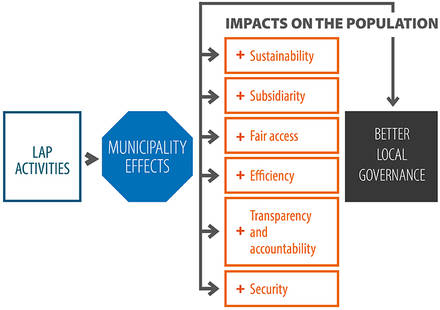The importance of subnational entities for governance
Municipalities and local governance
According to their own form of management and their guidelines for local development, municipal governments can define different types of indicators useful for evaluating the efficiency, effectiveness and impacts of intervention, as well as of aspects of institutional strengthening mentioned above; all these can contribute towards better local governance. The governance framework defined by UN-HABITAT1 allows an analysis of how LAPs can strengthen governance at municipal level by improvements in relation to sustainability, subsidiarity, fair access, efficiency, transparency and security.
Thematic areas of municipal governance with respect to land administration services
Thematic areas of municipal governance with respect to land administration services
Thematic Areas of Municipal Governance | Application as Regards LAS |
|---|---|
1) Sustainability | Through the policy of raising taxes, territorial planning and investment in infrastructure, offering a balanced focus on the social, economic and environmental problems of the population, taking into account the needs of future generations. |
2) Subsidiarity | The exercise of functions and powers in the field of territorial planning and land administration services, considering the competences of other institutions at departmental and national level (registration, cadastre, regularization of tenure, head of territorial planning, etc.). |
3) Fair access | Men and women and minority groups should participate equally in priority planning processes and in resource allocation and distribution. |
4) Efficiency | The way in which land administration services in local economies are financially sustainable and the ability of LAS to respond promptly to information requests. |
5) Transparency and accountability | Making decisions and the application of land administration services should be accompanied by standards and regulations. |
6) Civic commitment and exercise of citizenship | Citizens should be empowered to participate effectively in decision-making processes. |
7) Security | As an increase in security and legal certainty of tenure related to prevention of persecution and forced evictions and to better local planning against natural disasters. |
Land Tenure Governance in Communal Land and Indigenous Territories
There are numerous indigenous groups in Central America which make up more than 10 percent of the population in countries such as Guatemala, Mexico, Belize and Panama. The land occupied by these groups has been subject to colonization processes, agrarian reforms and more recently tenure regularization programmes funded by governments and international cooperation. These territories predominantly have customary administration systems and forms of tenure governed by ancestral occupation. The recognition of these management and tenure forms has been a constant part of the historical claims of these peoples. The implementation of the Safeguards for Indigenous Peoples and the LGAF established by the World Bank, and the VGGT established by the Committee on World Food Security and the FAO, as well as the FAO policy on Indigenous and Tribal Peoples2, currently demand respect for these territorial rights and for the forms of government and management of these territories as factors in responsible tenure governance.
Part 3, chapter 9 of the VGGT invites state and non-state players to recognize the social, cultural, spiritual, economic, environmental and political value contained in land, fishing and forests for indigenous peoples and other communities which practice self-governance. In particular it mentions the need for states to provide adequate recognition and protection for the legitimate tenure rights of indigenous peoples and other communities with traditional tenure systems. The Land Governance Assessment Framework (LGAF) also highlights the importance of this recognition in its legal and institutional dimension (Thematic area 1).
As regards administration of tenure, part 5 of the VGGT mentions the need for land registers to consider traditional systems and provide appropriate access to LAS for the population, bringing services within reach of the most vulnerable populations in particular. Territorial planning and inspection services, which form part of the powers of municipal governments and of some indigenous territories of the Central American region, are mentioned in both the VGGT (part 3) and the LGAF (Thematic area 2), as essential land administration services.
Effects at different interventional levels on the recognition of collective tenure rights of ICT are related to different evaluation indicators of LAPs. To see which indicators they relate to, see The evaluation of LAP effects at tenure governance level in ICT and the fact sheet on Analysis of tenure governance in ICT.



